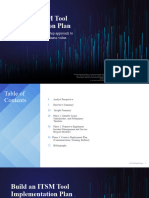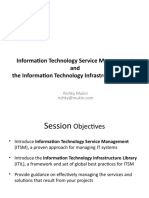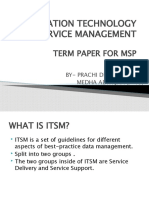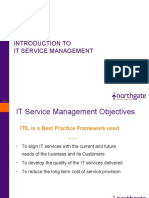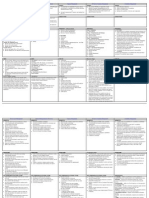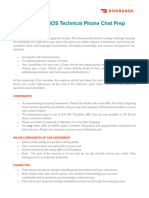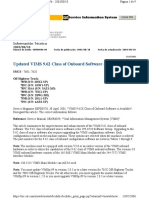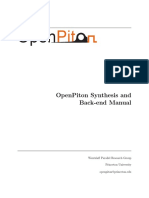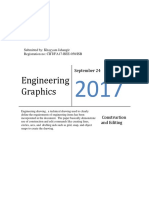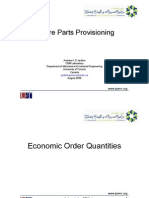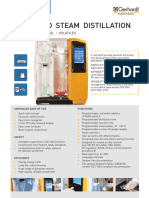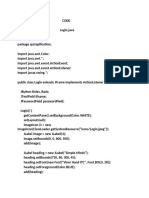ITSM Reference Document For Implementation and Support
Uploaded by
mohammed naeemITSM Reference Document For Implementation and Support
Uploaded by
mohammed naeemITSM Reference Document for
Implementation and Support
1. Purpose
This document serves as a comprehensive reference for the implementation and support of IT
Service Management (ITSM) processes, tools, and governance. It is intended for internal teams
and external stakeholders to ensure alignment and best practices in the delivery of ITSM
services.
2. Scope
Covers all phases of ITSM implementation and ongoing support, including:
• Assessment and planning
• Tool configuration and customization
• Process design and rollout
• Integration with existing systems
• Knowledge transfer and training
• Support and maintenance
3. ITSM Framework
The implementation is aligned with ITIL 4 best practices, covering key service management
processes:
Core ITSM Processes Implemented:
• Incident Management
• Problem Management
• Change Management
• Service Request Management
• Configuration Management (CMDB)
• Knowledge Management
• Service Level Management
• Asset Management (optional)
• Release & Deployment Management (optional)
4. Implementation Approach
4.1 Project Phases
Phase Description
Initiation Stakeholder alignment, project kickoff, tool access, requirement gathering
Design Process design, workflows, form design, SLAs, service catalog definition
Build Tool configuration, integration with AD, email, monitoring, asset systems
Testing UAT, end-to-end process testing, bug fixes, enhancement feedback
Go-Live Production deployment, hypercare support
Transition Handover to support team, training sessions, user guides delivered
4.2 Roles and Responsibilities
Role Responsibility
Project Manager Delivery oversight, stakeholder reporting
Process Consultant Design and document ITSM processes
Tool Expert Configure ITSM tool as per requirements
QA Lead UAT, issue logging, quality assurance
Client SPOC Approvals, feedback, escalation point
Support Team Ongoing issue resolution, maintenance
5. Tool Configuration Guidelines
• Multi-tier categorization (Category → Subcategory → Item)
• Custom SLA and escalation matrix
• Notification rules and approval workflows
• Integrations: LDAP/SSO, Monitoring Tools (e.g., Nagios, Zabbix), Email
(SMTP/IMAP), etc.
• Dashboards and Reporting for each module
6. Training & Knowledge Transfer
Activity Details
End-user Training Hands-on training for users (incidents, requests, approvals)
Admin Training Deep-dive for tool admins and L2 support
Documentation SOPs, user guides, knowledge base articles
KT Sessions Live sessions recorded and shared with client team
7. Support Model
7.1 Support Tiers
Tier Scope
L1 Basic user queries, how-to support
L2 Configuration fixes, minor enhancements
L3 Backend/database issues, major bugs, tool upgrades
7.2 SLAs (Sample)
Priority Response Time Resolution Time
P1 – Critical 1 hour 4 hours
P2 – High 4 hours 8 hours
P3 – Medium 1 business day 3 business days
P4 – Low 2 business days 5 business days
7.3 Support Channels
• Email Support (support@company.com)
• Ticketing System (ITSM Portal)
• Phone Support (if included)
• Onsite Support (if included)
8. Governance & Reporting
8.1 Reporting
• Weekly Status Reports (WSR)
• Monthly Service Review Reports (MSR)
• SLA & Performance Reports
• Root Cause Analysis (RCA) for major incidents
8.2 Governance Cadence
Meeting Frequency Participants
Weekly Status Weekly Client PM, Vendor PM
Change Advisory Board (CAB) Bi-weekly Process Owners, Tech Leads
Service Review Monthly Management, Ops Leads
Continual Improvement Planning Quarterly All stakeholders
9. Continual Service Improvement (CSI)
• CSI Register maintained
• Automation opportunities identified
• Regular audits of incident trends, SLA breaches
• Periodic CMDB health checks
• New features and roadmap planning
10. Tools & Platforms (Sample)
Category Tool
ITSM Platform ServiceNow / BMC Remedy / Jira Service Management / Freshservice
Monitoring Zabbix / Nagios / SolarWinds
CMDB Integration Discovery tools, SCCM
Automation Power Automate / RPA tools
Reporting Power BI / native dashboards
11. Assumptions
• Client provides timely access to stakeholders and environments
• All custom development or integrations are scoped and approved in advance
• Client owns business continuity and disaster recovery environments
12. Appendix
• RACI Matrix
• SOP Samples
• Change Request Template
• UAT Sign-off Template
• KT Completion Certificate







